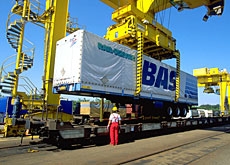
getting cargo through the alpine bottleneck

For years, Switzerland has been trying to convince transport firms to move cargo off trucks onto the railways as alpine passages reach saturation.
Part of this strategy has been to combine rail and road transport, but the message is not getting through to hauliers, who are still putting more trucks on the road.
Switzerland is the European champion when it comes to rail transport. In 2005, nearly two thirds of cargo in transit travelled by rail.
In Austria, which has a similar position to Switzerland, trains carried less than a quarter of all goods transported through the country last year. In Europe as a whole, the average is just 16 per cent.
The Swiss result owes much to government efforts: the authorities chose to make the transfer of goods off the road and onto the railways one of the main planks of its transport policy. After voters accepted the so-called Alpine Initiative in 1994, this policy was enshrined in the constitution.
Since then, deeds have followed intentions. The decision to build two new rail tunnels under the Alps is considered proof of this by most observers.
A tax on heavy goods vehicles was introduced, and Bern has actively given its support to road-rail transfers. The Swiss authorities have, for example, paid for shuttle terminals in Germany and Italy.
Combined transport
“We are the pioneers of combined transport in Europe,” said Irmtraut Tonndorf, spokeswoman for Hupac, the company that sends trucks and containers through Switzerland by rail.
“The idea was developed in the
United States in 1965. We adapted it to our geographical and structural reality.”
Hupac says that it has tried since 1967 to introduce regular technical as well as commercial innovations. One example is its Shuttle Net service, which provides non-stop transport across Europe.
“We have also paid close attention to our rolling stock, either by reducing its weight to save energy or by lowering our wagons to carry semi-trailers that would not pass through tunnels otherwise,” added Tonndorf.
In 2005, the company loaded 520,000 trucks or containers on its trains, nearly 16 per cent more than the previous year.
The so-called rolling highway, which carries complete trucks through zones where access is difficult or the presence of vehicles is detrimental to the environment, constitutes just five per cent of Hupac’s business.
The rest is made up of containers or trailers.
Attractive option
Specialists say combined rail-road transport, especially for containers and trailers, becomes an attractive option for distances over 600 kilometres, and just 300 in the Alps.
“It’s true that moving containers and trailers by rail over long distances is a solution for the future,” concedes Beat Keiser of
the Swiss Road Transport Association. “But you have to admit that it is attractive because of generous government subsidies.”
The trouble is that this solution is having trouble keeping up with the growth in goods transport. Despite Hupac’s positive results, road transport continues to increase both in Switzerland and abroad.
While road transport represented just over a quarter of the market in 1995, it was over a third in 2005. But this figure has remained stable for three or four years and the number of heavy vehicles crossing the Alps has fallen since 2000.
It is significant that even in Switzerland, where rail transport is heavily backed, trucks are gaining
ground. Enough anyway to make some businessmen happy.
“Combined rail-road transport is working, but not in the way everyone planned it,” smiles Hans-Ruedi Müller, president of the Swiss Roadbuilders Association.
swissinfo, Marzio Pescia
Swiss transport policy calls for most goods transport to be taken off the road and put on trains.
The number of trucks transiting through Switzerland is supposed to drop to 650,000 by 2009 (1.2 million in 2005) – a target that is unlikely to be met.
Hupac is the leader in combined rail-road transport through the Alps.
Combined transport uses at least two modes of transport: road, rail, air or sea. Road transport is only used for local movement.
Over the past 20 years, cargo transport through the Alps has doubled.
In 1981, 90% of goods transported travelled by train.
Today, this figure is slightly less than two thirds.
However, Switzerland remains one of the European leaders in this field.

In compliance with the JTI standards
More: SWI swissinfo.ch certified by the Journalism Trust Initiative




























You can find an overview of ongoing debates with our journalists here . Please join us!
If you want to start a conversation about a topic raised in this article or want to report factual errors, email us at english@swissinfo.ch.